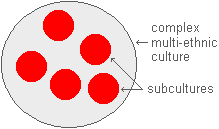Is the Total Pattern of a Groups Customs Beliefs Art and Technology
What is Culture?
 | |
| Edward B. Tylor (1832-1917) |
The word culture ![]() has many different meanings. For some information technology refers to an appreciation of expert literature, music, fine art, and food. For a biologist, it is likely to be a colony of bacteria or other microorganisms growing in a nutrient medium in a laboratory Petri dish. However, for anthropologists and other behavioral scientists, culture is the full range of learned man behavior patterns . The term was outset used in this mode by the pioneer English Anthropologist Edward B. Tylor in his book, Primitive Culture, published in 1871. Tylor said that culture is "that complex whole which includes noesis, belief, art, police force, morals, custom, and any other capabilities and habits caused by man every bit a member of society." Of course, it is not express to men. Women possess and create information technology besides. Since Tylor'southward time, the concept of civilization has get the fundamental focus of anthropology.
has many different meanings. For some information technology refers to an appreciation of expert literature, music, fine art, and food. For a biologist, it is likely to be a colony of bacteria or other microorganisms growing in a nutrient medium in a laboratory Petri dish. However, for anthropologists and other behavioral scientists, culture is the full range of learned man behavior patterns . The term was outset used in this mode by the pioneer English Anthropologist Edward B. Tylor in his book, Primitive Culture, published in 1871. Tylor said that culture is "that complex whole which includes noesis, belief, art, police force, morals, custom, and any other capabilities and habits caused by man every bit a member of society." Of course, it is not express to men. Women possess and create information technology besides. Since Tylor'southward time, the concept of civilization has get the fundamental focus of anthropology.
Culture is a powerful human being tool for survival, but information technology is a fragile phenomenon. Information technology is constantly changing and easily lost because it exists only in our minds. Our written languages, governments, buildings, and other human being-made things are merely the products of culture. They are not culture in themselves. For this reason, archaeologists can not dig upwardly culture directly in their excavations. The broken pots and other artifacts of aboriginal people that they uncover are only fabric remains that reverberate cultural patterns--they are things that were made and used through cultural knowledge and skills.
Layers of Civilisation
There are very likely three layers or levels of culture that are function of your learned behavior patterns and perceptions. About obviously is the body of cultural traditions that distinguish your specific social club. When people speak of Italian, Samoan, or Japanese culture, they are referring to the shared language, traditions, and beliefs that set each of these peoples apart from others. In virtually cases, those who share your culture practise so because they caused it equally they were raised past parents and other family members who have it.
 | |
The 2nd layer of civilization that may be part of your identity is a subculture ![]() . In complex, diverse societies in which people have come from many different parts of the world, they often retain much of their original cultural traditions. As a result, they are likely to be part of an identifiable subculture in their new order. The shared cultural traits of subcultures ready them autonomously from the rest of their lodge. Examples of easily identifiable subcultures in the United states of america include ethnic groups such as Vietnamese Americans, African Americans, and Mexican Americans. Members of each of these subcultures share a common identity, food tradition, dialect or language, and other cultural traits that come from their mutual bequeathed background and feel. As the cultural differences between members of a subculture and the dominant national civilisation mistiness and somewhen disappear, the subculture ceases to be except every bit a group of people who claim a mutual beginnings. That is generally the case with German Americans and Irish Americans in the U.s.a. today. Nearly of them identify themselves as Americans first. They also meet themselves equally being office of the cultural mainstream of the nation.
. In complex, diverse societies in which people have come from many different parts of the world, they often retain much of their original cultural traditions. As a result, they are likely to be part of an identifiable subculture in their new order. The shared cultural traits of subcultures ready them autonomously from the rest of their lodge. Examples of easily identifiable subcultures in the United states of america include ethnic groups such as Vietnamese Americans, African Americans, and Mexican Americans. Members of each of these subcultures share a common identity, food tradition, dialect or language, and other cultural traits that come from their mutual bequeathed background and feel. As the cultural differences between members of a subculture and the dominant national civilisation mistiness and somewhen disappear, the subculture ceases to be except every bit a group of people who claim a mutual beginnings. That is generally the case with German Americans and Irish Americans in the U.s.a. today. Nearly of them identify themselves as Americans first. They also meet themselves equally being office of the cultural mainstream of the nation.
 | These Cuban American women in Miami, Florida take a shared subculture identity that is reinforced through their language, food, and other traditions |
The third layer of culture consists of cultural universals . These are learned behavior patterns that are shared by all of humanity collectively. No thing where people live in the world, they share these universal traits. Examples of such "human being cultural" traits include:
| ane. | communicating with a verbal language consisting of a limited set of sounds and grammatical rules for constructing sentences |
| ii. | using age and gender to classify people (e.g., teenager, senior citizen, adult female, man) |
| 3. | classifying people based on marriage and descent relationships and having kinship terms to refer to |
| 4. | raising children in some sort of family setting |
| 5. | having a sexual division of labor (e.g., men's work versus women's work) |
| 6. | having a concept of privacy |
| vii. | having rules to regulate sexual behavior |
| 8. | distinguishing between expert and bad beliefs |
| 9. | having some sort of trunk ornamentation |
| 10. | making jokes and playing games |
| 11. | having art |
| 12. | having some sort of leadership roles for the implementation of community decisions |
While all cultures have these and possibly many other universal traits, unlike cultures have adult their ain specific ways of carrying out or expressing them. For example, people in deaf subcultures often employ their hands to communicate with sign language instead of verbal language. Withal, sign languages have grammatical rules just every bit exact ones exercise.
Culture and Society
Culture and gild ![]() are non the same matter. While cultures are complexes of learned behavior patterns and perceptions, societies are groups of interacting organisms . People are not the only animals that have societies. Schools of fish, flocks of birds, and hives of bees are societies. In the case of humans, yet, societies are groups of people who directly or indirectly collaborate with each other. People in human societies as well generally perceive that their gild is distinct from other societies in terms of shared traditions and expectations.
are non the same matter. While cultures are complexes of learned behavior patterns and perceptions, societies are groups of interacting organisms . People are not the only animals that have societies. Schools of fish, flocks of birds, and hives of bees are societies. In the case of humans, yet, societies are groups of people who directly or indirectly collaborate with each other. People in human societies as well generally perceive that their gild is distinct from other societies in terms of shared traditions and expectations.
While human being societies and cultures are non the same thing, they are inextricably connected considering culture is created and transmitted to others in a society. Cultures are not the product of lone individuals. They are the continuously evolving products of people interacting with each other. Cultural patterns such equally language and politics make no sense except in terms of the interaction of people. If you were the simply human being on earth, there would exist no need for linguistic communication or government.
Is Culture Express to Humans?
 | Non-human culture? This orangutan female parent is using a peculiarly prepared stick to "fish out" food from a crevice. She learned this skill and is now teaching it to her child who is hanging on her shoulder and intently watching. | ||
There is a divergence of stance in the behavioral sciences about whether or not nosotros are the only creature that creates and uses culture. The answer to this question depends on how narrow culture is defined. If it is used broadly to refer to a complex of learned behavior patterns, so it is clear that we are not alone in creating and using culture. Many other animal species teach their immature what they themselves learned in lodge to survive. This is peculiarly true of the chimpanzees and other relatively intelligent apes and monkeys. Wild chimpanzee mothers typically teach their children about several hundred food and medicinal plants. Their children too take to learn about the authorization bureaucracy and the social rules inside their communities. Every bit males become teenagers, they acquire hunting skills from adults. Females have to learn how to nurse and intendance for their babies. Chimpanzees even have to learn such basic skills as how to perform sexual intercourse. This knowledge is non hardwired into their brains at nascency. They are all learned patterns of beliefs only as they are for humans.
This folio was last updated on Fri, May 26, 2006 .
Copyright � 2002-2006 by Dennis O'Neil. All rights reserved.
Illustration credits
Source: https://www2.palomar.edu/anthro/culture/culture_1.htm
Postar um comentário for "Is the Total Pattern of a Groups Customs Beliefs Art and Technology"